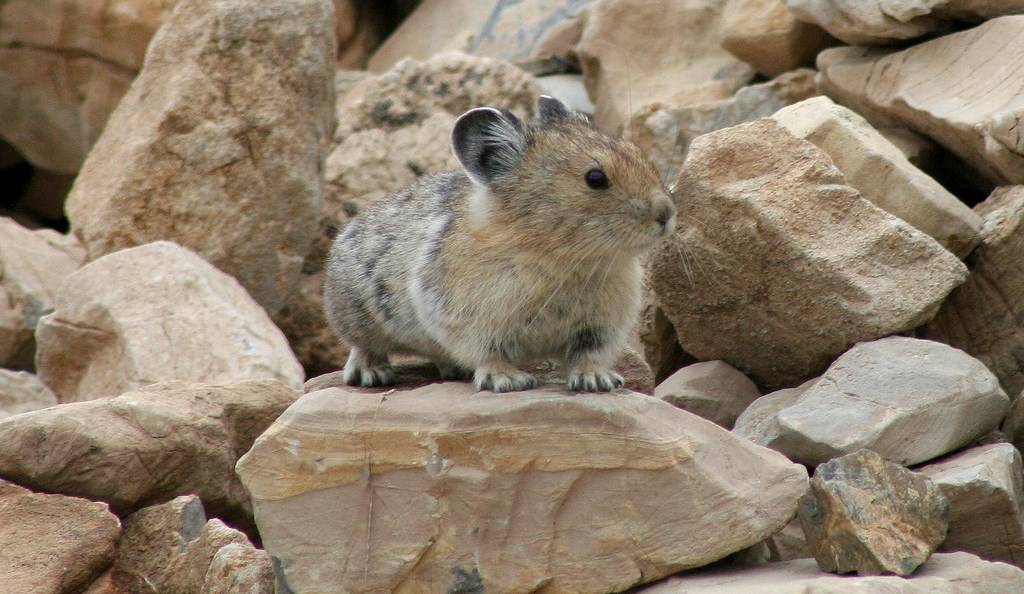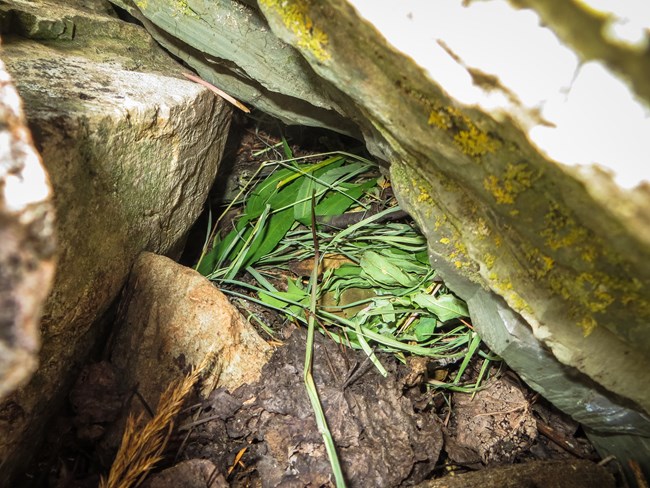Last updated: September 12, 2019
Article
Pikas Resource Brief
Background Information

NPS
Threats
Glacier National Park has garnered attention due to its receding glaciers, but climate change may also have an impact on alpine species like the pika. Climate models predict that the average temperature in North America will rise by 2-10°F by the end of the 21st century. Northwest Montana’s average temperature has risen 2.7°F (1.8 times the global average) in the last century, with high elevation areas warming at an even faster rate. Increasing temperatures could reduce the amount of suitable pika habitat. Additionally, encroachment of conifers into alpine or subalpine meadows may reduce available forage as well as obstruct a pika’s ability to detect predators. Since pikas do not hibernate, they rely on the insulating effect of ample snow to survive harsh winter temperatures. A reduced snowpack or earlier snowmelt, due to a changing climate, may also limit their habitat range and ability to survive.
Glacier-carved peaks, waterfalls, mountain goats, and grizzly bears all define the alpine country of Glacier National Park. What many people do not see are the smaller, less obvious members of this dramatic environment. Take the potato-sized, furry, North American pika (Ochotona princeps) for instance, found among talus slopes in the park. Pikas are in the order Lagomorpha, related to rabbits, and have evolved to live in cold climates on the fringe of talus slopes and meadows with suitable vegetation.
Through scent marking and aggression, individual pikas defend home territories of approximately 4,300 square feet. Pikas are generalized herbivores that also eat their caecal pellets, or protein-filled fecal droppings, typical of all lagomorphs. Not only do pikas feed directly on plants and pellets, but they collect and store them as well. Since pikas do not hibernate, these storage caches, known as haypiles, provide supplemental nutrients to help the pika survive the nine-month alpine winter. Excellent cold-climate survivalists, their thick, furry coat and high metabolism keep their body temperature at 104°F. These attributes benefit pikas in the winter, but are ineffective for staying cool in warmer weather. In fact, a pika begins to experience potentially fatal stress levels when its body temperature reaches 109°F. Predicted warming, due to climate change, may pose problems for pikas, especially if the areas they inhabit are experiencing consistently hotter summer days. A succession of hot days may force pikas to spend more time underneath the talus to regulate their body temperature, which would mean less time spent above ground foraging for food.
Status and Trends
Prior to the Early Holocene Era, over 8,000 years ago, pikas lived in valley bottoms and grassland habitats in North America rather than the colder alpine areas of today. This long-term shift in habitat preference is important for understanding how the pika is likely to respond to a changing climate. Evidence from the Great Basin shows that during the past 8,000 years, as the climate has generally warmed, pika populations have become locally extinct in lower elevations and have grown increasingly isolated on mountaintops. Recent surveys of Great Basin sites, where pikas were abundant within the last 110 years, show that they have disappeared from 44% of these sites. Pikas at higher elevations in the southern Rocky Mountains, however, persisted in a much higher percentage of sites. The effects of climate change on the pika in Glacier National Park are unknown. If the alpine warms at predicted rates, even the mountain summits may not be cold enough to sustain pika populations. Warming temperatures may also affect pika reproduction. Averaging only 2-3 offspring per litter, a pika’s first (and most successful) of two litters is conceived one month prior to the melting alpine snow pack. Timing is critical because it provides the lactating female pika with an abundance of food when she needs it most. Earlier snow melt and unpredictable winter snow pack depths may disrupt natural timing, potentially leaving the offspring and mother susceptible to starvation.
From 2007 to 2009, former PhD student Lucas Moyer-Horner conducted a study monitoring pikas in Glacier National Park. From this data, he estimated that there were between 1,800 and 3,600 pika in Glacier. Simultaneously, the Crown of the Continent Research Learning Center launched a citizen science project to help with pika monitoring. Pika surveys are conducted by volunteers to determine distribution of pikas in the park and to monitor any occurring changes. The primary goal of the project is to discover which potential sites pikas inhabit and which they do not. Using results from these studies, biologists hope to learn more about pika persistence over time.

NPS
Management Strategy
Due to their vulnerability to high temperatures, increasingly isolated populations, and low reproductive rates, scientists are concerned about how climate change will affect the North American pika. Additional monitoring will greatly improve our understanding of how pika distribution may be affected by a changing climate. Glacier is one of nine national parks that conducted these surveys as part of a larger pika inventory and monitoring program led by the National Park Service’s Upper Columbia Basin Inventory & Monitoring Network. The data collected complemented Moyer-Horner’s study to establish a foundation for long-term monitoring of this charismatic creature of the alpine. Since the pika citizen science project began in 2008, scientists and volunteers have surveyed 46 established sites annually. The data collected as of 2018 has shown that pika occupancy of these sites has decreased on average.
The Glacier National Park Citizen Science Program provides an excellent opportunity to continue long-term pika monitoring as well as educate the public on climate change impacts to pikas. The program plans to continue pika monitoring using citizen scientists, improving detection precision, and collecting detailed baseline data.
Resources for More Information
Glacier National Park Staff
- Tara Carolin, Director, Crown of the Continent Research Learning Center
- Jami Belt, Biologist, Citizen Scientist Program
Documents and web sites
- NPS Inventory & Monitoring “Pikas in Peril” webpage – https://www.nps.gov/articles/pikas-in-peril.htm
- The International Union for Conservation and Nature Red List – https://www.iucnredlist.org/species/41267/45184315
- Pikas in Peril press release – https://irma.nps.gov/DataStore/Reference/Profile/2253554
The Crown of the Continent Research Learning Center
Phone: 406-888-5827; Email: glac_citizen_science@nps.gov
Website: www.nps.gov/rlc/crown
